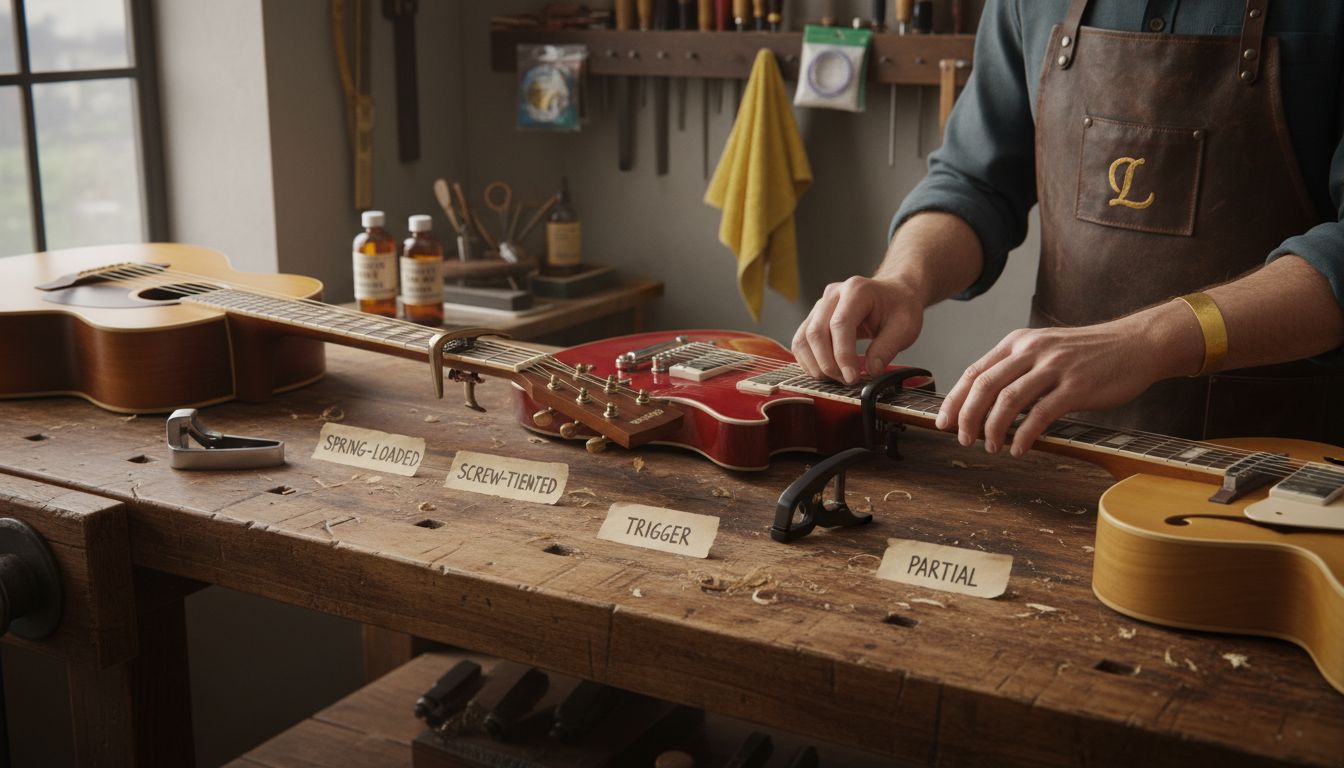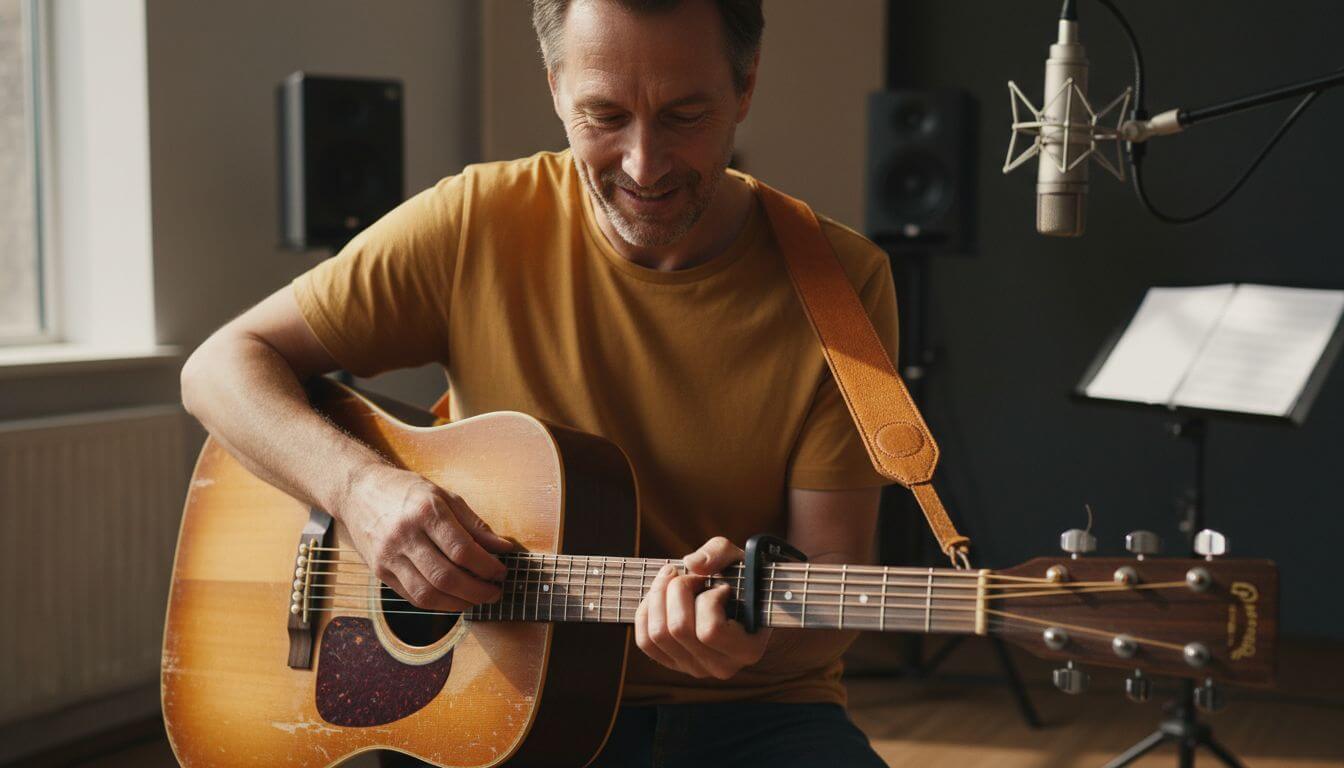Did you know that over 70 percent of professional guitarists use a capo on stage and in the studio? Many players think a capo is just a beginner’s shortcut, but in truth, it unlocks a world of creative options for musicians at every level. Understanding what a capo does and clearing up old myths will help you discover new sounds, easier playing, and more ways to express your musical ideas.
Table of Contents
- Capo Definition And Typical Misconceptions
- Types Of Capos And Key Differences
- How A Capo Works On Acoustic And Electric
- Popular Uses And Musical Applications
- Choosing, Setting Up, And Maintaining Your Capo
- Common Mistakes And Troubleshooting Tips
Key Takeaways
| Point | Details |
|---|---|
| Capo Importance | A capo is an essential tool for guitarists that enables key transposition and simplifies complex chord progressions across various musical genres. |
| Types of Capos | Different capo types (spring-loaded, screw-tightened, trigger, and partial) cater to varying playing styles and offer unique advantages in terms of tension adjustment and usage. |
| Proper Use | Correct placement and maintenance of the capo are crucial to avoid tuning issues and instrument damage, requiring attention to detail during application. |
| Versatile Applications | Capos enhance musical creativity by allowing for vocal range adjustments, unique tonal textures, and simplified chord fingerings tailored to the guitarist’s needs. |
Capo Definition and Typical Misconceptions
A capo is a small but powerful device guitarists use to change the pitch and key of their instrument without learning complex chord shapes. According to Merriam-Webster, a capo is “a movable bar attached to the fingerboard of a fretted instrument to uniformly raise the pitch of all the strings”.
Many guitarists misunderstand capos, believing they’re only for beginners or limited in musical application. In reality, capos are sophisticated tools used by professional musicians across multiple genres. From folk and country to rock and indie, skilled players leverage capos to create unique tonal variations, simplify challenging chord progressions, and explore alternative voicings.
The fundamental mechanism of a capo is straightforward yet ingenious. When clamped onto a guitar’s neck, it acts like a movable nut, effectively shortening the playable string length and raising the pitch. This means you can play familiar open chord shapes in different keys without changing your fingering. Some typical misconceptions include thinking capos only work for acoustic guitars or that they limit musical creativity - both of which are entirely untrue.
Key benefits of using a capo include:
- Instant key transposition
- Easier chord voicings
- Enhanced tonal flexibility
- Simplified playing across different vocal ranges
Types of Capos and Key Differences
Guitar players have several capo types to choose from, each designed to suit different playing styles and instrument requirements. According to Wikipedia), most commercial capos consist of a rubber-covered bar that clamps to the instrument’s neck to hold down the strings, but the mechanisms vary significantly.
The primary capo types include spring-loaded, screw-tightened, trigger, and partial capos. Spring-loaded capos are the most common, featuring a simple squeeze mechanism that quickly attaches to the guitar neck. Screw-tightened capos offer more precise tension control, allowing musicians to adjust pressure for optimal string contact. Trigger capos provide rapid on-off capabilities, perfect for performers who need quick key changes during live performances.
A unique variation is the partial capo, which Wikipedia defines as “a device that shortens the playable length of some of the strings on a musical instrument, as opposed to a standard capo which affects all of the strings”. This specialized tool opens up creative tuning possibilities, enabling guitarists to explore unconventional chord voicings and alternative sound textures.
Key differences between capo types include:

Here’s a comparison of the main capo types and their key characteristics:
| Capo Type | Attachment Mechanism | Tension Adjustment | Key Advantages |
|---|---|---|---|
| Spring-loaded | Squeeze and release | Fixed | Quick use Portable |
| Screw-tightened | Screw fastener | Adjustable | Precise tension Stable |
| Trigger | Trigger clamp | Fixed | Rapid on/off Performance use |
| Partial | Custom placement | Varies | Creative tunings Unique sounds |
- Attachment mechanism
- Tension adjustment capabilities
- Weight and portability
- Compatibility with different guitar necks
- Speed of placement and removal
How a Capo Works on Acoustic and Electric
Understanding how a capo functions is crucial for guitarists looking to expand their musical versatility. According to Wikipedia), a capo is a device musicians use to “transpose and shorten the playable length of the strings—hence raising the pitch” across both acoustic and electric guitars.
On an acoustic guitar, the capo clamps directly onto the neck, pressing all strings down at a specific fret. This effectively creates a new “nut” that shortens the playable string length, which raises the overall pitch of the instrument. The beauty of this mechanism is that you can continue playing your familiar open chord shapes, just in a higher key. As Wikipedia) notes, musicians commonly use capos to “play in a different key using the same fingerings as playing open”.
Electric guitars work identically to acoustics when using a capo. The primary difference lies in the guitar’s construction and pickup sensitivity. Some electric guitarists might find capos slightly more challenging to attach due to narrower necks or different neck profiles, but the fundamental pitch-changing principle remains the same. When placed correctly, a capo on an electric guitar will produce the same transposition effect as on an acoustic.
Key operational aspects of capos include:
- Uniform string compression
- Precise pitch elevation
- Maintaining original chord shapes
- Instant key change capabilities
- Minimal impact on instrument setup
For guitarists seeking to explore different tonal possibilities, our guide to choosing the perfect Acoustic guitar can provide additional insights into instrument selection and technique.
Popular Uses and Musical Applications
The capo is far more than a simple accessory - it’s a transformative tool that spans multiple musical genres and playing styles. According to Wikipedia), some guitar styles like flamenco, Irish traditional music, and British and American folk music frequently incorporate capos as a core part of their sound.
Rock and roll musicians have embraced the capo with remarkable creativity. Wikipedia) highlights an impressive roster of legendary artists who regularly use capos, including icons like Keith Richards, Bob Dylan, Tom Petty, and George Harrison. These musicians leverage capos to achieve unique tonal qualities, simplify complex chord progressions, and explore alternative voicings that might be difficult to play in standard tuning.
Beyond genre boundaries, capos serve multiple practical purposes for musicians. They enable singers to transpose songs to more comfortable vocal ranges, allow guitarists to play familiar chord shapes in different keys, and provide creative solutions for adapting arrangements. Whether you’re performing an intimate acoustic set, writing original music, or jamming with a band, a capo offers unprecedented musical flexibility.
Key musical applications include:
- Vocal range accommodation
- Instant key transposition
- Simplified chord fingerings
- Unique tonal textures
- Enhanced creative expression
For guitarists looking to dive deeper into instrument techniques, the importance of guitar parts guide offers additional insights into musical versatility.
Choosing, Setting Up, and Maintaining Your Capo
Selecting the right capo requires careful consideration of multiple factors. According to Wikipedia), musicians should evaluate capos based on “ease of use, size, degree of interference with the player’s hands, and ability to hold down strings uniformly without affecting tuning”.
Proper capo placement is critical for maintaining sound quality and instrument integrity. Wikipedia) recommends that capos should be “applied after a fresh tuning by laying the barre, descending from above, and directly behind the fret, so that all of the strings have uniform position and pressure”. This precise placement ensures minimal string distortion and optimal pitch preservation.
Maintaining your capo involves regular inspection and gentle cleaning. Look for signs of wear on the rubber padding, check the tension mechanism, and ensure it can still apply even pressure across all strings. Avoid storing capos in extreme temperatures or leaving them attached to your guitar for extended periods when not in use, as this can potentially warp the instrument’s neck or damage the capo’s mechanism.
Key considerations when choosing a capo include:
- Compatibility with your guitar’s neck width
- Tension adjustment capabilities
- Material durability
- Weight and portability
- Ease of quick attachment and removal
For guitarists seeking comprehensive instrument care advice, our professional guitar setup guide provides additional insights into maintaining your instrument’s optimal performance.
Common Mistakes and Troubleshooting Tips
Using a capo might seem straightforward, but guitarists frequently encounter subtle challenges that can compromise their sound and instrument. According to Wikipedia), one critical issue is that “if the strings are bent or mispositioned, the instrument sounds out of tune in the new key” - a problem that can frustrate even experienced musicians.
Another significant concern is potential damage to your instrument. Wikipedia) warns that “some types of capo can mar the neck of the guitar if applied incorrectly”. This means guitarists must be exceptionally careful about capo placement, tension, and the specific type of capo they’re using.
Avoid cheap, poorly designed capos that might have uneven pressure or sharp edges that could scratch your guitar’s finish.
Preventing common capo-related issues requires attention to detail and gentle handling. Always tune your guitar after applying the capo, as slight tension changes can affect pitch. Check that the capo is positioned directly behind the fret, not on top of it, and ensure uniform pressure across all strings. If you notice buzzing or intonation problems, readjust the capo or consider trying a different style that might better suit your specific instrument.
Top troubleshooting tips include:
- Tune after capo placement
- Check for even string pressure
- Avoid overtightening the capo
- Inspect capo for wear and damage
- Use capos designed for your specific guitar type
For guitarists looking to maintain their instrument’s best condition, our professional guitar setup guide offers comprehensive advice on preventing and addressing potential playing issues.
Elevate Your Sound with the Perfect Capo from MusicStreet.co.uk
Mastering your guitar using a capo is a game changer but choosing the right one can be overwhelming. If you want to avoid tuning issues, uneven string pressure or damage to your instrument, selecting a high-quality capo that suits your guitar’s neck and playing style is essential. Whether you are a folk enthusiast aiming for unique tonal textures or a rock guitarist seeking quick key changes during live performances, the right capo can unlock new creative possibilities while keeping your instrument safe and in tune.

Explore MusicStreet.co.uk for a carefully curated selection of capos and guitar accessories designed with precision and durability. With expert advice and a commitment to premium instruments, we help you find gear that enhances your playing experience instantly. Don’t settle for less when it comes to your sound and instrument care—visit MusicStreet today to choose your perfect capo and take advantage of our professional setup services. Start transforming your guitar playing now and feel the difference that quality makes.
Frequently Asked Questions
What is a capo and how does it work?
A capo is a device used by guitarists to clamp down on the strings at a specific fret, effectively raising the pitch of all the strings. It allows musicians to play familiar chord shapes in different keys without learning new fingerings.
What are the different types of capos available?
The primary types of capos include spring-loaded, screw-tightened, trigger, and partial capos. Each type has distinct mechanisms and advantages, catering to different playing styles and needs.
How do I properly place a capo on my guitar?
To correctly place a capo, apply it after tuning your guitar. Position it directly behind the fret and ensure even pressure across all strings to avoid tuning issues and buzzing sounds.
Can I use a capo on both acoustic and electric guitars?
Yes, capos work on both acoustic and electric guitars. The placement and function remain the same, although some electric guitars may require attention due to narrower necks or different profiles.




Share:
How to Restring a Guitar for Optimal Tone and Playability
How to Read Guitar Tabs (Beginner’s Step‑by‑Step Guide)